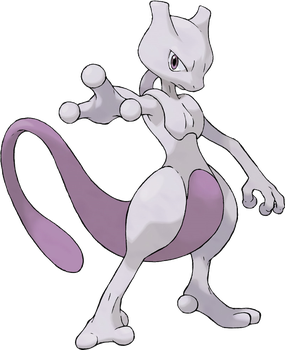
Mewtwo is a Pokémon species in Nintendo and Game Freak's Pokémon media franchise. It was first introduced in the video games Pokémon Red and Blue, and later appeared in subsequent sequels and spin-off titles, such as Pokkén Tournament and Detective Pikachu. In the video games, the player can fight and capture Mewtwo in order to subsequently pit it against other Pokémon. The player can first learn of Mewtwo late in Pokémon Red and Blue by reading research documents left in a ruined laboratory on Cinnabar Island where Mewtwo has escaped. Mewtwo is regarded as one of the series' strongest Pokémon, often referred to as "the world's strongest Pokémon" in various media, and was the strongest in the original games in terms of base statistic distribution. It is known as the "Genetic Pokémon" and is a Legendary Pokémon, a special group of Pokémon that are very rare and usually very powerful. Mewtwo has also appeared in various animated adaptations of the franchise.

Pokémon Ruby Version and Pokémon Sapphire Version are 2002 role-playing video games developed by Game Freak and published by The Pokémon Company and Nintendo for the Game Boy Advance. They are the first installments in the third generation of the Pokémon video game series, also known as the "advanced generation". After years of Nintendo being the sole publisher of the franchise in all regions, The Pokémon Company co-published the games for the first time since the establishment of the joint-owned company in 1998. They were first released in Japan in late 2002, and internationally in 2003. Pokémon Emerald, a third version, was released two years later in each region. Remakes of the two games, titled Pokémon Omega Ruby and Alpha Sapphire, were released for the Nintendo 3DS worldwide in November 2014, exactly twelve years to the date of the original Ruby and Sapphire release date, with the exception of Europe, where it released a week later.
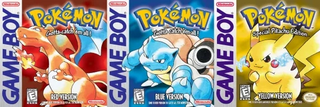
Pokémon Red Version and Pokémon Blue Version are 1996 role-playing video games (RPGs) developed by Game Freak and published by Nintendo for the Game Boy. They are the first installments of the Pokémon video game series, and were first released in Japan as Pocket Monsters Red and Pocket Monsters Green, followed by the special edition Pocket Monsters Blue later that year. The games were released internationally in 1998 and 1999 as Pokémon Red and Pokémon Blue, while an enhanced version named Pokémon Yellow Version: Special Pikachu Edition, was released in Japan in 1998 and in other regions in 1999 and 2000.

Pokémon FireRed Version and Pokémon LeafGreen Version are 2004 remakes of the 1996 role-playing video games Pokémon Red and Blue. They were developed by Game Freak and published by The Pokémon Company and Nintendo for the Game Boy Advance. FireRed and LeafGreen were first released in Japan in January 2004 and in North America and Europe in September and October 2004. The games are part of the third generation of the Pokémon video game series and hold the distinction of being the first enhanced remakes of previous games within the franchise.
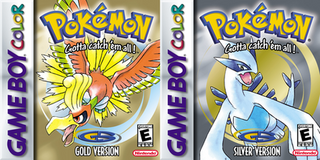
Pokémon Gold Version and Pokémon Silver Version are 1999 role-playing video games developed by Game Freak and published by Nintendo for the Game Boy Color. They are the first installments in the second generation of the Pokémon video game series. They were released in Japan in 1999, Australia and North America in 2000, and Europe in 2001.
Tecmo, Ltd., was a Japanese video game corporation founded in 1967. It had its headquarters in the Kudankita district of Tokyo. Its subsidiary, Tecmo Inc, was located in Torrance, California. Prior to 1986, Tecmo was formerly known as Tehkan.
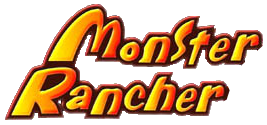
Monster Rancher, known in Japan as Monster Farm, is a Japanese media franchise and series of life simulation role-playing video games created by Tecmo. The series consists of fifteen games across numerous different video game platforms, and an anime adaptation that aired from 1999 to 2000.

Berserk and the Band of the Hawk, known in Japan as Berserk Musou, is a Musō game developed by Omega Force and published by Koei Tecmo for PlayStation 3, PlayStation 4, PlayStation Vita, and Microsoft Windows. It is a collaboration between Koei Tecmo's Dynasty Warriors video game series and Kentaro Miura's Berserk manga series. Berserk and the Band of the Hawk was released for PlayStation 3, PlayStation 4 and PlayStation Vita in Japan on October 27, 2016, and worldwide for Microsoft Windows, PlayStation 4 and PlayStation Vita in February 2017.

Gallop Racer is a series of horse racing video games, created by Tecmo.
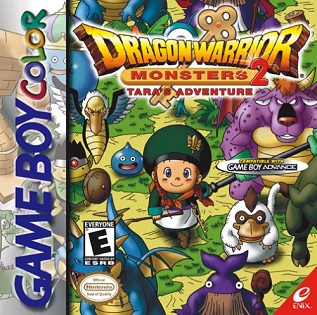
Dragon Warrior Monsters 2, known in Japan as Dragon Quest Monsters 2, is a role-playing video game published by Enix for the Game Boy Color. It is the second Dragon Warrior Monsters game for the Game Boy Color and features two different versions of the same game, Cobi's Journey and Tara's Adventure. Both games were remade in 2002 for the PlayStation in a compilation game called Dragon Quest Monsters 1+2 and released only in Japan. The Nintendo 3DS version combined both games into one and was released only in Japan in 2014 with the title Dragon Quest Monsters 2: Iru and Luca's Marvelous Mysterious Key. The 3DS version was later brought to iOS, Android on August 6, 2020, in Japan.

Koei Tecmo Holdings Co., Ltd. is a Japanese video game, amusement and anime holding company created in 2009 by the merger of Koei and Tecmo. Koei Tecmo Holdings owns several companies, the biggest one of those being its flagship video game developer and publisher Koei Tecmo Games that was founded in 1978 as Koei. Known as Tecmo Koei until the names were reversed in 2014, the company had occasionally used the "Koei" and "Tecmo" brand names on new video games for marketing purposes until 2016.
Unown is a Pokémon species in Nintendo and Game Freak's Pokémon franchise. Created by Ken Sugimori, Unown first appeared in the video games Pokémon Gold and Silver and most of its subsequent sequels. It has also appeared in various merchandise, spin-off titles, and animated and printed adaptations of the franchise. Unown are hieroglyph-like, thin, black ancient Pokémon usually found on walls. There are twenty-eight forms of Unown: one for each of the twenty-six letters in the Latin alphabet, a question mark, and an exclamation mark. Unown is a Psychic-type Pokémon, and is not able to evolve.
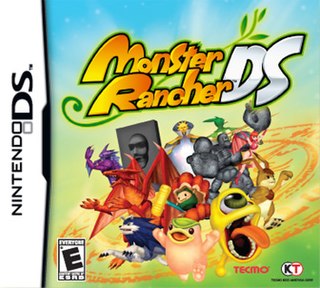
Monster Rancher DS is a life simulation video game developed by Cing and published by UFO Interactive Games for the Nintendo DS. It was released in Japan on August 7, 2008 and in North America on August 3, 2010. The game was not released in Europe.

Dead or Alive Paradise is a 2010 video game developed by Project Venus and published by Tecmo Koei for the PlayStation Portable as part of the Dead or Alive series. It is a PSP port of Dead or Alive Xtreme 2 for the Xbox 360, expanding upon the activities available in the original which consisted of mainly beach-related minigames.

Pokémon Conquest, known in Japan as Pokémon + Nobunaga's Ambition, is a 2012 tactical role-playing video game developed by Tecmo Koei and published by The Pokémon Company and Nintendo for the Nintendo DS. The game is a crossover between the Pokémon and Nobunaga's Ambition video game series. The game was released in Japan on March 17, 2012, in North America on June 18, 2012, and in Europe on July 27, 2012.
Gallop Racer 2003: A New Breed, known in Japan as Gallop Racer 6: Revolution, and in Europe as At the Races Presents Gallop Racer, is a horse racing video game developed and published by Tecmo, released in 2002-2003 for the PlayStation 2.

Gallop Racer 2004, known in Japan as Gallop Racer Lucky 7, and in the PAL region as Gallop Racer 2, is a horse racing video game developed and published by Tecmo, released in 2004 for the PlayStation 2.
Chronos Materia is a cancelled role-playing video game by Gust Co. Ltd. The title was announced in 2013 as a PlayStation Vita exclusive title, but was quietly cancelled in April 2016. The game was intended to be a new IP by Gust, that would have mixed many of the aspects of their Atelier and Ar Nosurge series of games with elements of time travel.

Omega Force is a Japanese video game developer and a division of Koei Tecmo, founded in 1996 by Akihiro Suzuki and Kenichi Ogasawara, and is best known for the Dynasty Warriors video games.















